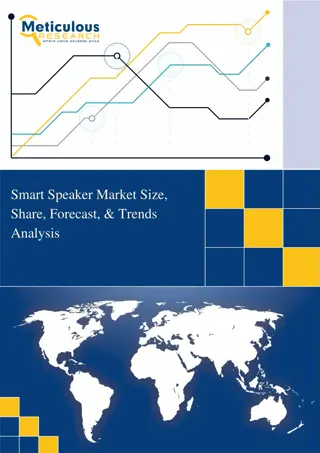
Activated Alumina Market
The global activated alumina market size is expected to be worth around USD 1724 Million by 2033, from USD 1018.9 Million in 2023, growing at a CAGR of 5.4% during the forecast period from 2023 to 2033.
Download Presentation

Please find below an Image/Link to download the presentation.
The content on the website is provided AS IS for your information and personal use only. It may not be sold, licensed, or shared on other websites without obtaining consent from the author. If you encounter any issues during the download, it is possible that the publisher has removed the file from their server.
You are allowed to download the files provided on this website for personal or commercial use, subject to the condition that they are used lawfully. All files are the property of their respective owners.
The content on the website is provided AS IS for your information and personal use only. It may not be sold, licensed, or shared on other websites without obtaining consent from the author.
E N D
Presentation Transcript
The global activated alumina market size is expected to be worth around USD 1724 Million by 2033, from USD 1018.9 Million in 2023, growing at a CAGR of 5.4% during the forecast period from 2023 to 2033. The activated alumina market encompasses the production, distribution, and application of activated alumina, a highly porous and absorbent material derived from aluminum hydroxide. This substance is widely used for its desiccant properties, making it essential in drying gases and liquids, water purification, and as a catalyst in various chemical processes. The market is driven by the demand in industries such as oil and gas, water treatment, and pharmaceuticals, where activated alumina's ability to remove impurities and contaminants is crucial. Its extensive use in air separation plants and as a fluoride adsorbent in municipal water systems further underscores its importance, shaping a growing and dynamic market. Market Key Players: BASF SE Honeywell International Inc. Sumitomo Chemical Co., Ltd Axens AGC CHEMICALS PVT. LTD. Sorbead India Shandong Zhongxin New Material Technology Co., Ltd. Luoyang Xinghua Chemical Co., Ltd. Sialca Industries Shayan Corporation BeeChems Hengye Inc. Huber Engineered Materials Click here for request a sample : https://market.us/report/activated-alumina-market/request-sample/
By Particle Size: The powder segment of the activated alumina market holds a notable share due to its widespread applications across various industries. Characterized by fine particle size, it is ideal for adsorbents in gas and liquid phases, catalyst carriers, and desiccants. The 0.5-2 mm segment represents a balance between surface area and particle size, making it suitable for dehydration and purification applications, with good efficiency in adsorption and minimal pressure drop. The 2-5 mm segment caters to applications requiring higher mechanical strength and adsorption properties, suitable for durability and resistance to attrition. The 5-10 mm segment, known for its larger granules, offers superior mechanical strength and structural integrity. Application Analysis: In 2023, the powder form of activated alumina dominated the market, capturing over 33.2% due to its efficacy in adsorbing substances in gases and liquids. It is extensively used in water purification, pharmaceuticals, and air cleaning. As a catalyst for the Claus reaction, its demand is expected to rise with refinery expansions. Activated alumina is also crucial for liquid and gas drying due to its large surface area and resistance to abrasion or thermal shock. The bioceramics application is projected to grow strongly from 2023 to 2032, with activated alumina ceramics being used in dental and bone applications due to their ability to withstand high temperatures and acidic environments. End-Use Analysis: In 2023, water treatment led the activated alumina market, accounting for more than 36.9%. It is widely used for purifying water, acting like a sponge that absorbs contaminants. The healthcare sector is expected to grow significantly from 2023 to 2032, with activated alumina bioceramics being an alternative to surgical alloys for dental implants and hip prostheses due to their low friction, anti-corrosion properties, and hardness. Other applications include the chemical, food and beverage, and nuclear industries. It is also used in high vacuum applications, such as in
foreline traps to prevent oil from rotary pumps from returning into the system. Key Market Segments By Particle Size Powder 0.5-2 mm 2-5 mm 5-10 mm By Application Catalyst Desiccant Fluoride Adsorbent Bio Ceramics Other Applications By End-Use Water Treatment Oil & Gas Plastics Healthcare Other End-Uses Drivers: The rising demand for activated alumina beads is fueled by the urgent need for water treatment, especially in developing countries. Governments are actively addressing water-related issues, boosting the demand for these highly porous and efficient beads. Additionally, the increased use of gas as an alternative fuel, such as CNG
and LNG, has significantly raised the demand for activated alumina. These beads are essential in dehydrating compressed gases, ensuring they remain free from moisture and contaminants, thereby supporting market growth. Opportunities: Activated alumina is pivotal in the oil and gas industry as a desiccant, absorbing substantial volumes of gases and liquids without chemical changes. It is crucial for dehydrating organic liquids and gases, including LPG, gasoline, and natural gas. This extensive application is expected to drive market expansion as the demand for pure gases and liquids increases. Furthermore, governments worldwide are investing heavily in upgrading water treatment infrastructure and technologies. For instance, China allocates around US$ 110 billion annually towards environmental protection, with a focus on wastewater treatment. This governmental commitment is anticipated to create significant market opportunities for activated alumina. Restraints/Challenges: The activated alumina market faces challenges from substitutes like zeolites and activated carbon, which offer similar performance qualities. Additionally, a potential decrease in the absorption capacity of activated alumina poses a significant challenge. This report on the activated alumina market provides insights into recent developments, trade regulations, import-export analysis, production assessments, value chain optimization, market share analysis, and the impacts of local and international players. It also identifies emerging revenue opportunities, examines evolving market regulations, and offers strategic growth analyses, including market size and category growth, application niches, product approvals, regional expansions, and technological advancements. For a deeper understanding, Data Bridge Market Research offers Analyst Briefs to aid informed decision-making and drive market growth.






















